Operable Wall Acoustics 101 is a combination technical and day to day commentary on acoustics as they apply to moveable walls/operable partitions etc. Sound Control is the single most important factor when choosing a moveable wall. But the topic of moveable wall acoustics is often made too complicated by manufacturers as they speak in technical rather than practical terms. The purpose of this question/answer commentary is to attempt to eliminate some of the mystery and explain sound control in terms that are easily understood. You will find herein terms, facts and truths as they apply to operable and moveable wall acoustics. We have included links to articles that expand on the points presented as well as links to independent sources of information which we have used to verify facts contained in this article. If you have any questions please contact Moderco.
This is a combination technical and day to day commentary on acoustics as they apply to moveable walls/operable partitions etc. Sound Control is the single most important factor when choosing a moveable wall. But the topic of moveable wall acoustics is often made too complicated by manufacturers as they speak in technical rather than practical terms. The purpose of this question/answer commentary is to attempt to eliminate some of the mystery and explain sound control in terms that are easily understood.
The accepted and most common way for an Architect/Specifier to assess and compare the acoustics of a selected wall is it’s STC. Thus a great deal of this commentary revolves around STC, what it is, where it came from, how it is determined and is it a reliable predictor of field sound quality? The “loudness” or “amplitude” of a sound wave is expressed by its sound pressure level (SPL) which is then expressed in “decibels” (dB) calculated using a logarithmic scale from 0 to 150.. The primary acoustic purpose of a moveable wall is to reduce as much as possible the transmission of sound (dB) through the wall.
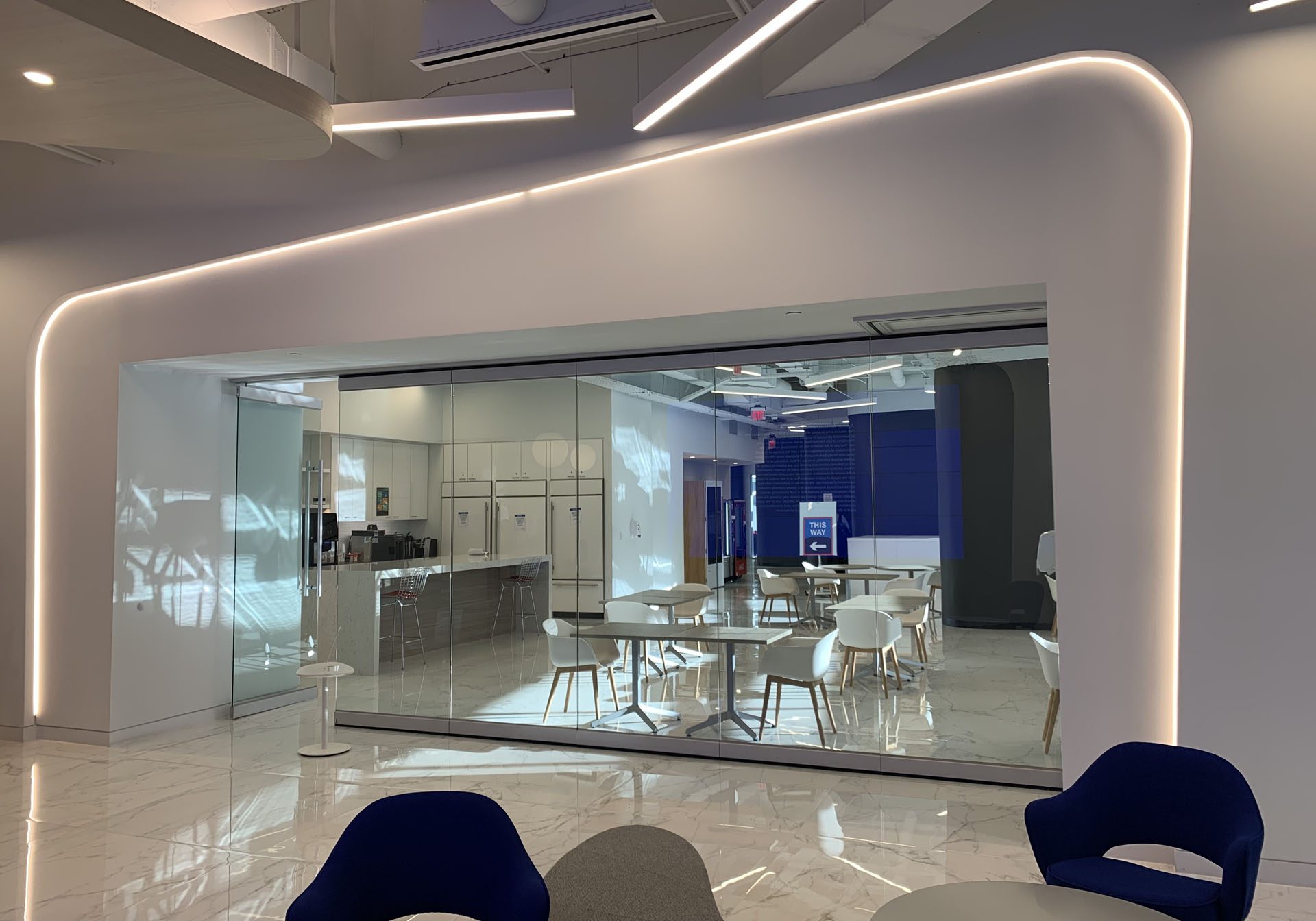
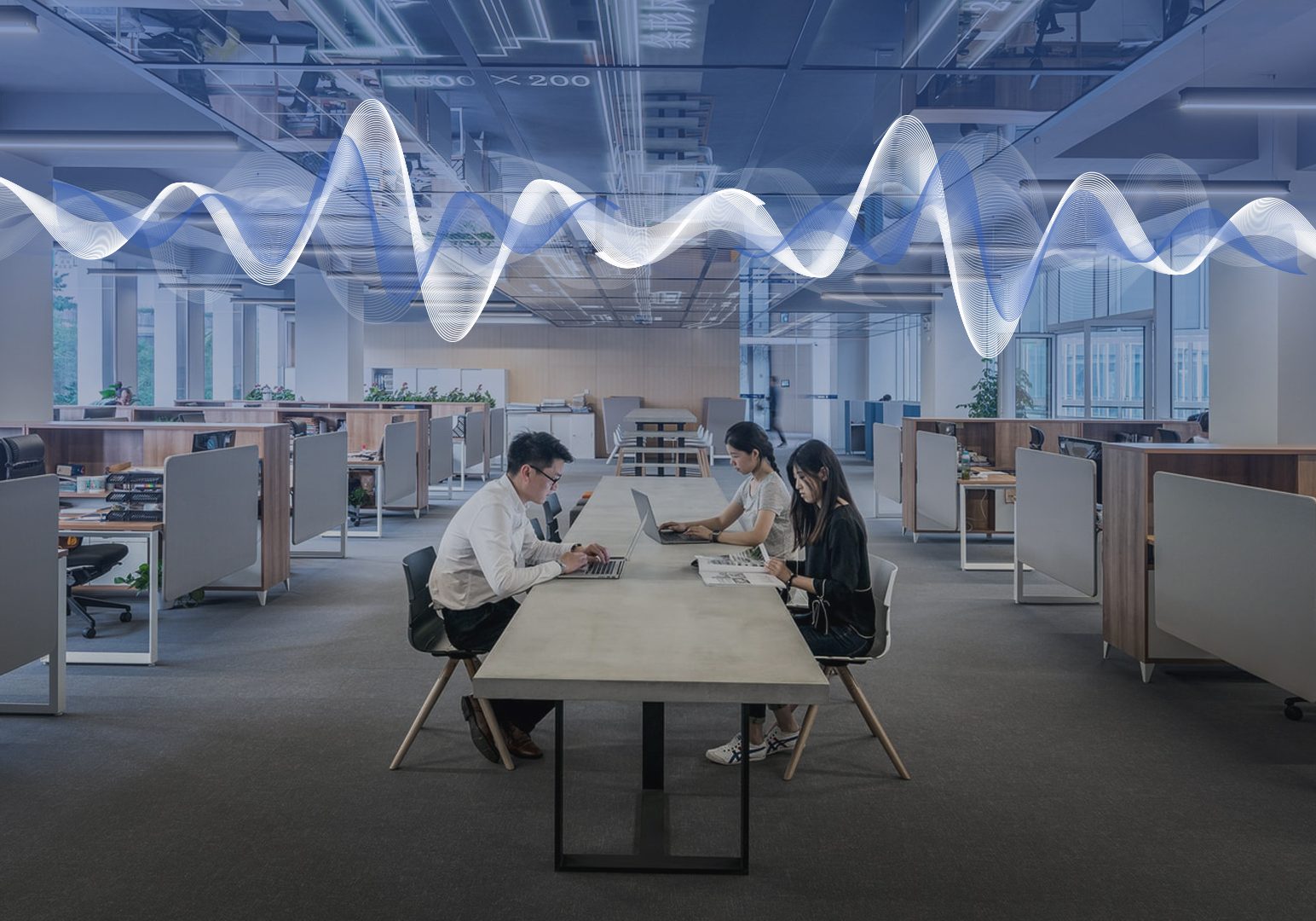
To determine this dB reduction (TL) through the wall, sound measured in dB’s across 16 frequencies (125 to 4000 Hz) and in a manner outlined in ASTM test procedure ASTM E-90. This sound is directed at the wall specimen. with the resulting loss at each frequency then determined. The results (reduction of dB through the wall at each frequency - STL) are calculated with the result, based on ASTM E- 413, then expressed as a single digit number identified as the walls STC. To be specific the STC is the dB transmission loss that occurs a 500 Hz.
What the consumer wants to know is how much “loudness, noise. dB “ will be lost if they install a moveable wall between two spaces in the field? To get a true picture you have to look at the loss at each individual frequency which is complicated and requires more acoustical knowledge and time than the average person has. So, for the purpose of this commentary the assumption is being made that 1 dB change equals 1 STC point change. (1) (2).This documented assumption allows the average person to be able to come to a quick and fairly confident conclusion as to the ability of a wall to stop noise (dB’s). Again - a “1” change in dB (loudness) is equal to a ”1” change in STC value. If, for example, a partition has an STC 40 that would mean that there will be a loss of 40 dB through the wall.
Much of the information in this commentary comes from “A Practical Guide to Noise Control. NBS Handbook 119” as published by the National Bureau of Standards, Washington DC.
STC is an acronym for “Sound Transmission Class”. It is a single number rating (an average) as determined by an ASTM test procedure (E-90) in an accredited laboratory and indicates quickly in a very general fashion as to how well a moveable wall attenuates (stops) airborne sound. In theory the higher the number the better. STC was initially developed so that specifiers and consumers could easily compare sound attenuation through moveable walls and other building elements.
KNOWING WHAT STC IS AND WHAT TO EXPECT AS A RESULT OF YOUR CHOICE
(dB) by +/- 1: Almost imperceptible. For example going from an STC 50 to 51 or 49 will not be noticed.
(dB) by +/- 3: Barely perceptible. Going from STC 50 to 53 or 47 will be evident
(dB) by +/- 5: Quite noticeable. Going from STC 50 to STC 45 or 55 will be significant.
(dB) by +/- 10: Dramatic. Twice (or half) as loud. (5) (2)
STC’s +/- 1 are considered equal: READ
Confidential. Cannot understand speech from next room. Music can be heard.
Normal. Occasionally hear sounds of adjacent activity. Speech audible. Music & loud noises clearly heard.
Marginal. Aware of presence of others in adjacent areas. Conversations occasionally understood.
Always aware of activities in adjacent areas. Activity and speech always heard and understood.
Conversations always heard and understood. All adjacent activities clearly audible.
The short and correct answer is “No”!
For a more detailed explanation as to how STC HAS BECOME WEAPONIZED. It explains how some manufacturers use the ambiguities in ASTM E-90 to their advantage rather than maintain the historically established standards of moveable wall testing. Read about the history of moveable wall laboratory sound testing, the way it was and the direction that it now appears to be going.
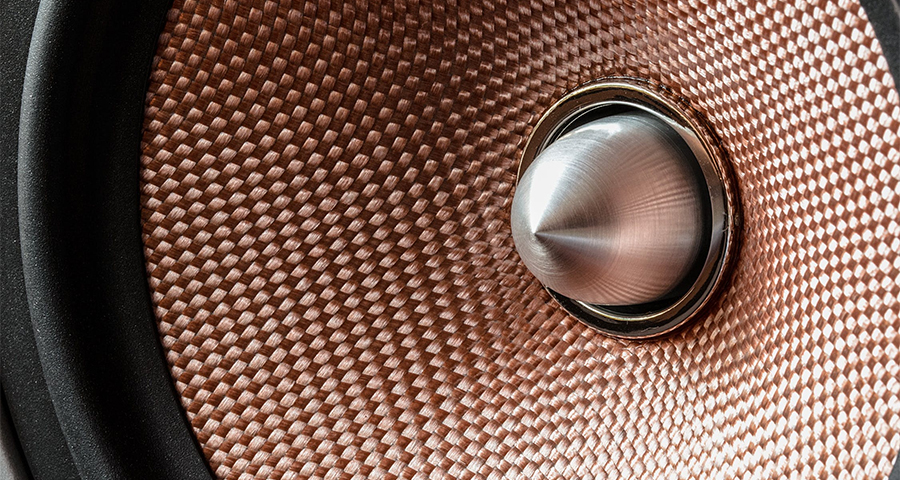
Amplitude (loudness) is measured in dB (decibels) and is a measurement of how LOUD a noise is. It is the volume knob on your receiver. As an example 10 dB is barely audible, 50 dB is normal conversation while 140 dB is really really loud: so much so it can injure.
Normal breathing
A ticking watch
Quiet home, soft whisper, a private office.
Average home environment, the hum of a refrigerator.
Normal conversation, an average office.
Conversational speech at 3 feet, an air conditioner.
Street noise, Noisy Office, a washing machine
Busy restaurant. City traffic
Noisy Factory. A motorcycle
Power lawnmower, car horn, a sporting event.
Loud radio, stereo, television, loud entertainment venues.
Shouting directly in your ear, Construction bulldozer, Thunder, Artillery.
Up close rock concert, Standing beside a siren. Threshold of pain.
Most of the dB levels that we encounter in the moveable wall business are in the 40 to 80 dB range.
Fireworks. (Painful.)
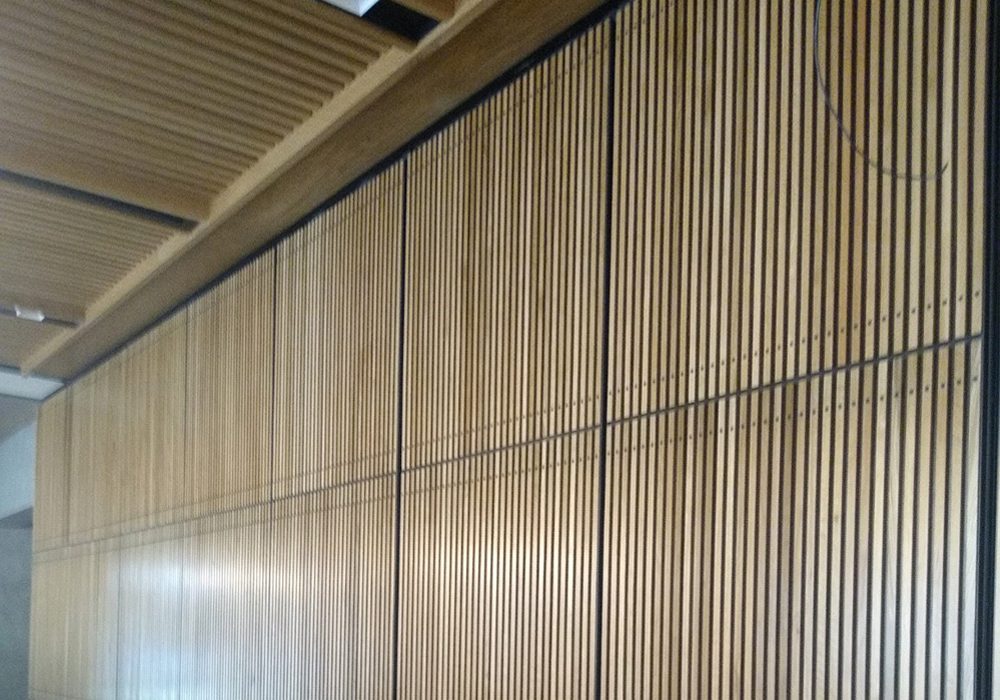
Hz (hertz) is “pitch”, a familiar term that we all use. 1 hertz equals one sound wave passing a fixed point in 1 second. A sound like a “whistle” has a high frequency with short wave lengths while a “drum” has a low frequency with long wave lengths. Human ears can register sounds from about 20 Hz up to about 20,000 Hz. Speech usually falls within the 100 to 8000 Hz range with many people having difficulty in discerning speech once it exceeds 3000-4000 Hz. Low frequency sounds (long wave lengths) are typically below 500 Hz – “rumbly” sounds from the bass on your sound system. Medium frequency sounds (medium wave lengths) are between 500 and 2000 Hz – human speech range, tinny and horn like quality. High frequency sounds (short wave lengths) start above 2000 Hz – speech sounds more real with quality.
One of the problems with relying on an STC alone is that STC only considers frequencies down to 125 Hz. This fact can be misleading due to the fact that most sound isolation complaints from moveable wall users about hearing noise are at frequencies below 125 HZ. For example most of the sound generated by amplified visual presentations, music systems, guitars, bass instruments or drum sets etc. are below 125 Hz. On the other hand most of the typical day to day speech frequencies that you would be expected to encounter in a classroom or meeting room are 125 to 4000 Hz which is where moveable walls are most effective.
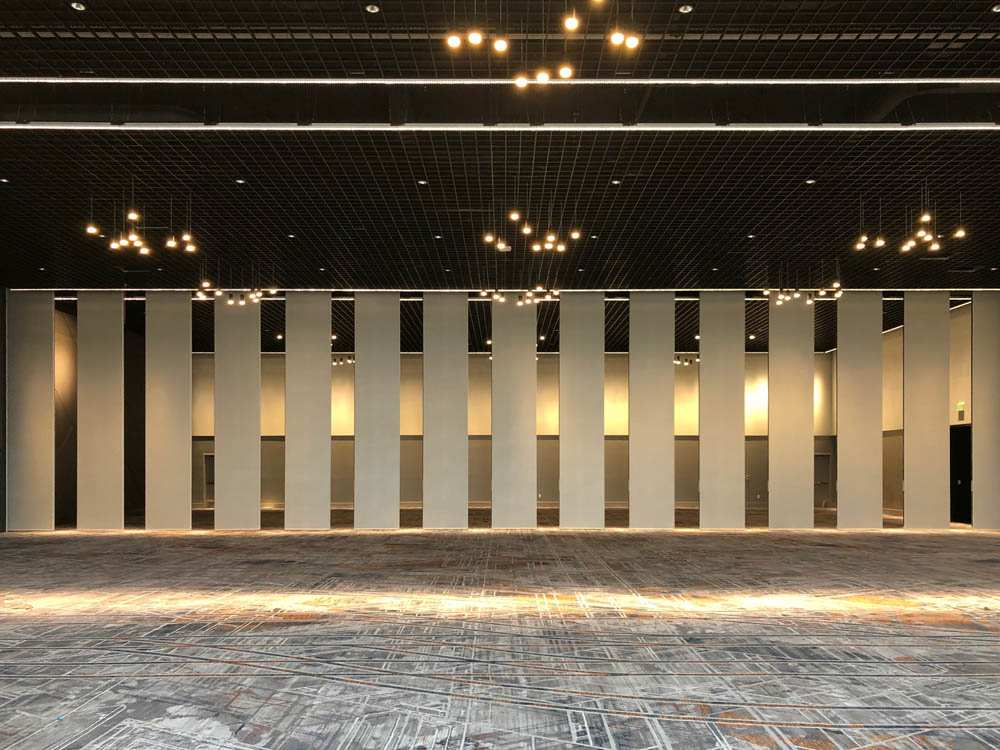
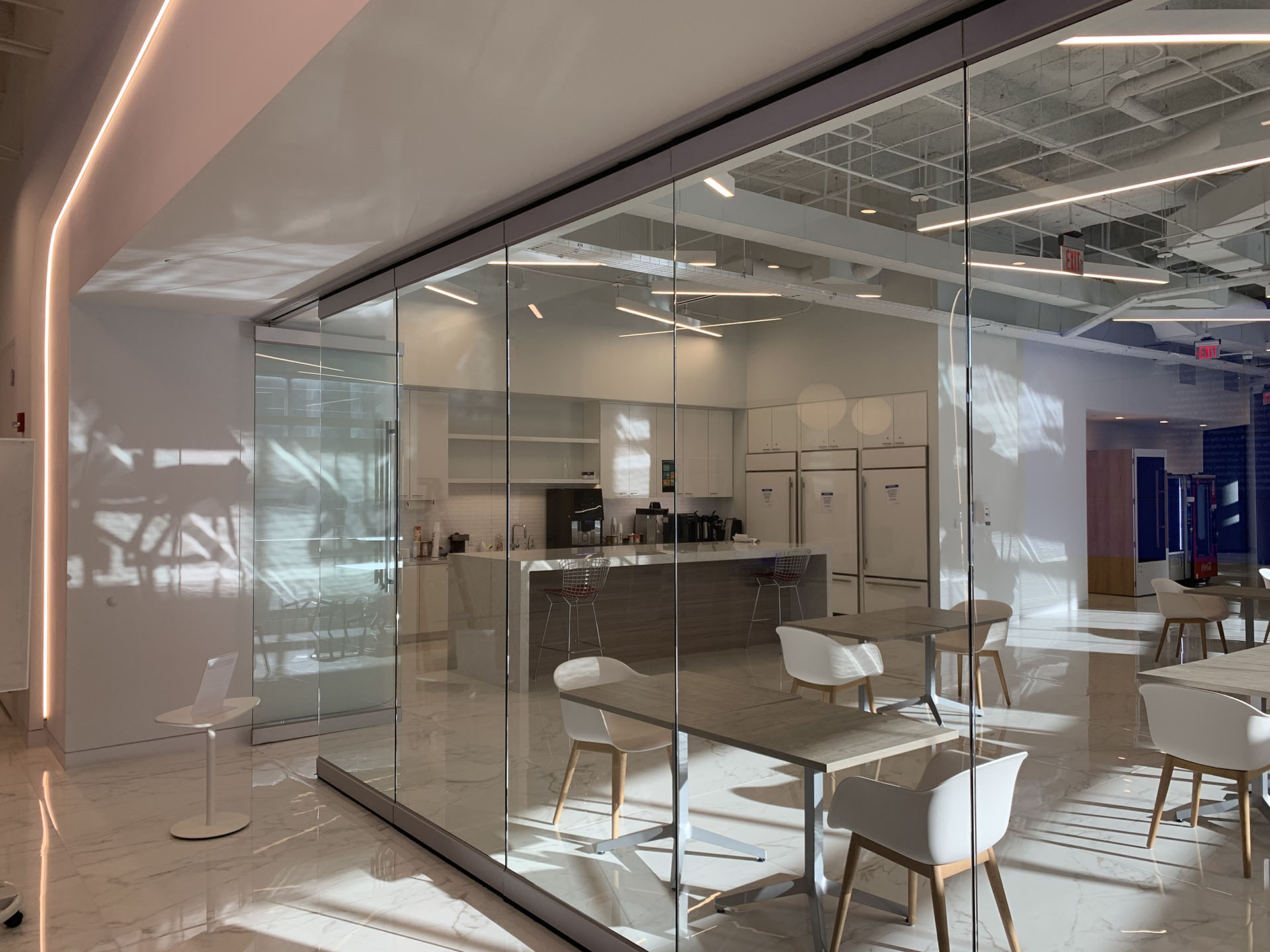
NIC (Noise Isolation Class) is a single number rating derived from a standard ASTM (E-336) field (not in the lab) conducted test procedure . The FIELD test is conducted on an installed moveable wall with the NIC value determined by measuring the sound pressure level difference through the installed product AND also taking into account sound that is transmitted through the surrounding construction including floors, permanent walls, ceiling, plenums, HVAX, electrical and plumbing systems: all building elements. The results are then calculated as per ASTM E-412 and reported as the moveable wall NIC. NIC is indicative of what the users of the room will experience. An NIC of 40 or more on a moveable wall is considered to be excellent. NIC is more indicative as to what the ear will hear. Typically an NIC value will be minimum 10 points less than the STC value obtained in the laboratory. If you can obtain an NIC of 40 or a bit more this is a great result.
We have defined STC – a number (an average) that indicates in general terms the ability of a moveable wall to control as best as possible the effectiveness at preventing sound from getting from one side to the other. We have defined dB as being the “loudness” of sound – noise. So in its most simplistic, layman, non- technical terms, 1 STC can be broadly defined as an indication of the walls ability to stop I dB of noise: 1 STC = 1 dB. For example, an STC of 50 is a relatively good indicator of a wall being able to stop 50 dB of noise. Not perfectly true but remember that STC itself is defined as an “average”. But the term STC is meaningless unless you can apply it to reality: to be able to actually “use” it rather than simply base your decisions on “higher is better”. So we suggest that when you are selecting a wall based on its “STC” number assume that 1 STC equals the loss of 1 dB through the wall. Therefore the place to start is not how high an STC will be provided by the moveable wall but what is the anticipated dB level that you wish to control as best as possible. There are some examples of various dB’s in this commentary as well as well as some tested STC values so let’s put the two of them together and include NIC. What do we have?
Assume there are a bunch of people in a meeting speaking in normal tones and generating 60 dB of noise. The selected moveable wall has a laboratory tested STC of 50 so 10 dB (60 – 50) of “noise” will make its way through just the partition to the other side which is negligible and acceptable. But if I put the same wall in a hospitality application with a rock concert on one side generating 100 dB, then 50 dB will make its way through the wall resulting in 50 dB of noise transference: annoying & noticeable to all on the receiving side. But the primary problem is that these numbers are all based on perfect laboratory conditions. If you introduce the dB of noise that makes its way through to the other side by means of sound leaks in the building construction (flanking paths) then the STC number will drop dramatically even more.
This is where NIC kicks in: what is the result when you install this STC 50 wall in the field? Typically a minimum of 10 STC points (dB) less than the laboratory STC value will result. Therefore In the real world the STC 50 wall, when one includes the sound leakage (10 dB) through the surrounding permanent building construction, will result in a receiving room dB of 20. (60 – 50 + 10 = 20 dB). This still works. But if the meeting being held is “noisy” accompanied by an amplified power point presentation, then the dB produced in the source space could be 80 dB or higher. The resulting sound heard in the receiving room would be 40 dB (80 – 50 + 10 = 40) which will be noticeable. A rock concert (100 -50 +10 = 60dB) would be more than annoying to the people holding the meeting.
Conclusion: In the field, a Lab STC 50 wall mostly likely become an STC 40 wall. In addition the acoustics of the moveable wall are only as good as the acoustic qualities of the surrounding construction. Call Moderco – we will work with you in order to select the right wall, STC, configuration as well as EXPLORE ALL SOLUTIONS based on the anticipated dB’s that will be generated.
First of all and most importantly look “past” the STC number. Many manufacturers rely on the fact that the reader will just look for a high “number” and move on. Not a good idea as how and when the STC “number” was achieved is critically important for acoustic satisfaction.
Ask for a “complete” copy of the test.
Confirm that the name of the company on the test is also the name of the company you are considering.
Ensure that the test says the Lab is NVLAP (National Voluntary Laboratory Accreditation Program) accredited.
ASTM E-90 is not the actual sound test: it is the original test “method”. Your sound test should say E-90 followed by a suffix which identifies the year that the test was accepted by the test committee: example ASTM E-90-09. ASTM E-90 by itself is meaningless and incomplete.
A general rule is that only the last 5 tests should be viewed as being acceptable: ASTM E-90-99, - 02, -04, -09, -16. Any other submitted sound test should be rejected as out of date. Some manufacturers regularly submit tests that are over 40 years old. One is now presenting in an AIA credit presentation that ASME E-90-70 is acceptable. This is ludicrous as this test is outdated and meaningless.
The description of the specimen tested must clearly show that it was on a moveable or operable wall (not a demountable or fixed wall) have a description of the materials used in its construction, include all essential features such as closures and perimeter acoustic seals and opened and closed 5 times prior to testing.
Compare what the manufacturer is proposing to supply with what is included in the sound test.
Once that wall is installed it is difficult to make modifications in order to improve its acoustics. It is what it is. A suggestion: Call us and we will provide a side by side comparison of a Moderco test to the one you are considering. Could prove to illuminating and insightful.

Yes and often a significant difference: an STC on a “fixed” will be much higher than on a “moveable”. But some manufacturers will present an STC on a “fixed in place” partition as being on a “moveable wall”. If the STC appears to be too good to be true ask questions or call Moderco and we will work with you to get the truth. The bottom line is look past the number and READ THE BODY OF THE TEST. Is the test you are reading clearly conducted – by name, by materials, by components, by test requirements – as being on a moveable wall? Check it out thoroughly before you make a product decision. Call us and we can quickly tell you.
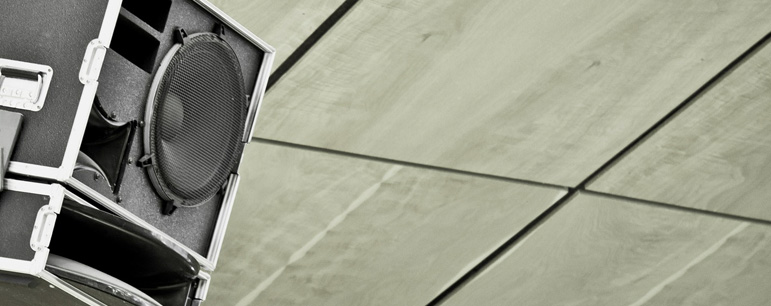
There isn’t supposed to be but it appears recently that some manufacturers are taking advantage of loopholes in the ASTM E-90 test procedure simply to acquire a higher number rather than determine the STC of a designed moveable wall assembly which is supposed to be the intent. One of the major weaknesses in ASTM E-90 is that it does not specify a “specimen” size or the number of panels that must be tested. E-90 simply indicates a minimum square footage dimension (62 square feet or approximately 8’ X 8’) with a minimum of 2 panels.
For years the accepted industry standard was a specimen sample that was 14’ wide X 9’ high (126 sq. ft.) with 4 panels. But some manufacturers are now testing 2 panels totalling the 62 sq. ft. This smaller size and only 2 panels, which is not representative of a moveable wall and cannot possibly include all essential components, will artificially elevate the STC value. STC has been transformed into a “sales feature” rather than an indicator of acoustic quality. We consider this wrong and somewhat deceptive even though we agree that under the way the E-90 test procedure is worded, it is acceptable. Moderco is very hesitant about adopting this method simply to secure a higher number and remains committed to laboratory sound test specimens in a 9’ X 14’ opening that reflects a true sample of a moveable wall and better indicates the acoustical expectations of the consumer.
Add Mass. The weight or thickness is the major factor in a moveable wall’s ability to block sound. Doubling the mass of a wall will increase the STC rating of a partition by 5dB (or STC points) which is noticeable
Increase or add Airspace: By doing this you are essentially creating two independent walls. 1.5” of airspace improves STC by approximately 3 points. 3” – 6 points. 6” – 8 points.
Add absorptive material within a hollow partition cavity: Results vary based on thickness etc. but 4 – 6 STC points could be expected
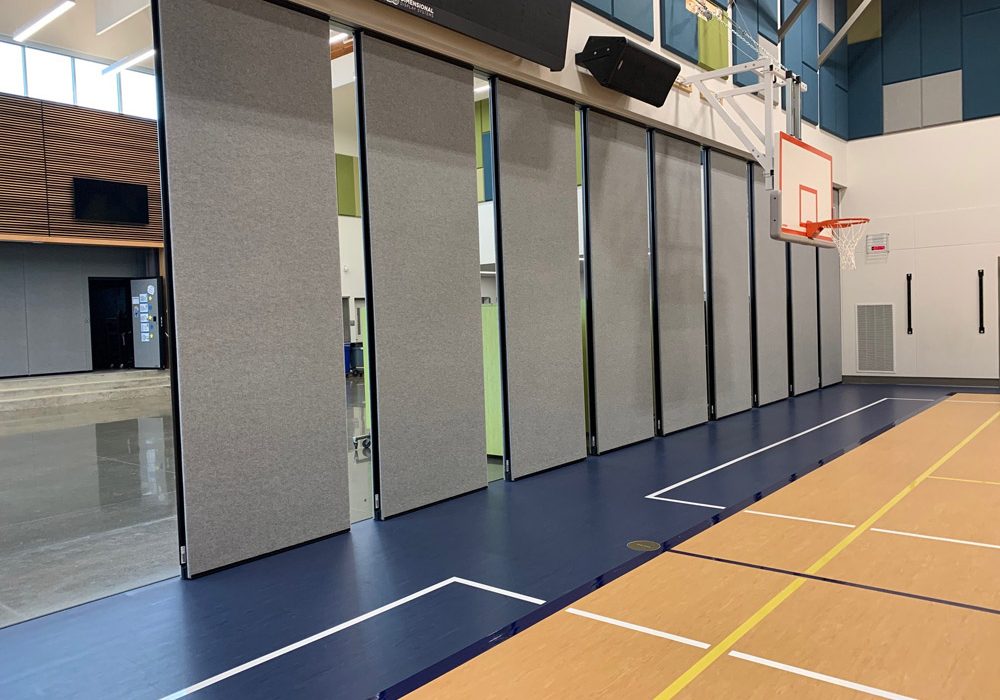
No – not in all cases. There are often many differences in what individual test procedures contain and not contain, when they were conducted, the test procedures involved and whether or not it was conducted using a current test procedure, the sizes of the test specimens etc. The test procedure can be played with to the advantage of the manufacturer. THERE IS MORE TO THE STC DECISION THAN JUST THE HIGHEST NUMBER. Contact us and we will objectively compare the Moderco sound test with the one you are considering.
It is a great starting point but simply assuming that the highest STC number is the best choice is not always correct.. STC is an average, a convenient point of comparison from which you begin a detailed search for information but as a specific & reliable indicator STC is quite limited and should not be totally relied upon for real world acoustic expectations. Call Moderco and we will tell you why. Read this commentary. Accumulate information. Make decisions based on facts.
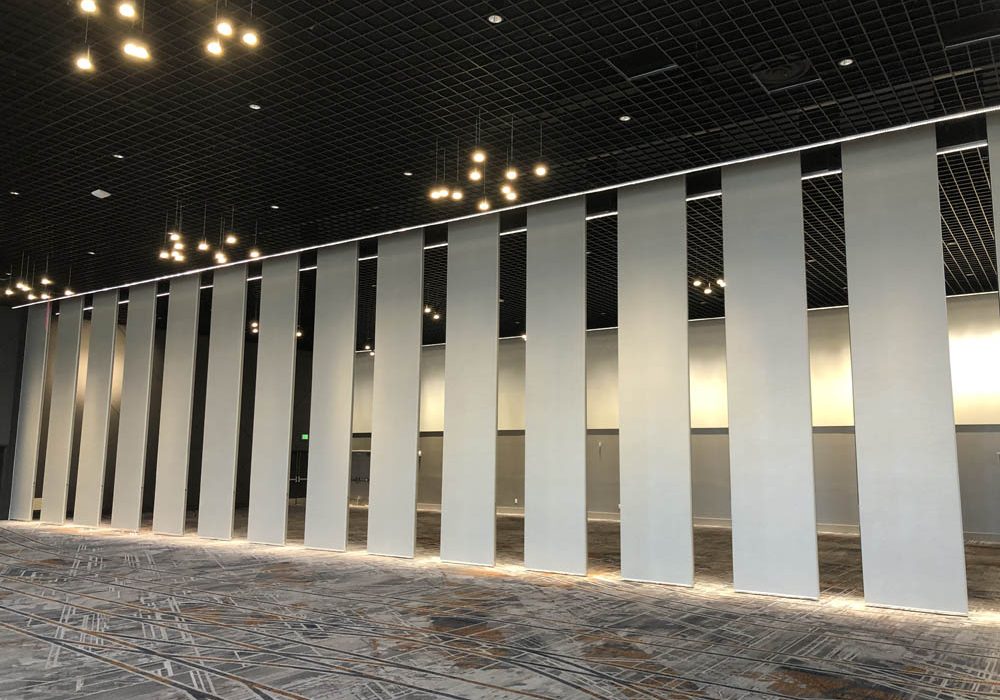
No. There is not an operable or moveable wall out there that will stop all sound from being transferred from one side to the other. In fact it is extremely difficult to make a permanent wall “soundproof”. So if someone tells you that their product is “soundproof” it is not true. Find a supplier who will tell you the truth and factually describe and validate how their product will perform after you describe your needs.
8” brick wall with .5” plaster on both sides. 9” thick
12” Poured Solid Concrete Wall
8” brick wall. 8” thick
2 layers of 0.5” gypsum board separated by staggered metal studs, 4” thick.
12” painted concrete block wall
8” Hollow Concrete Block Wall
6” concrete block wall, 6” thick
5/8” drywall on both sides of steel studs.
½” drywall on both sides of wood studs
total 4 layers of .62” gypsum board, total 2.5” thick
1.75” solid wood door with complete perimeter gaskets, total 1.75” thick
4” block wall – total 4” thick
1.75” hollow core wood door, no gaskets, total 1.75” thick
A hollow metal door without seals (8), (9), (10)
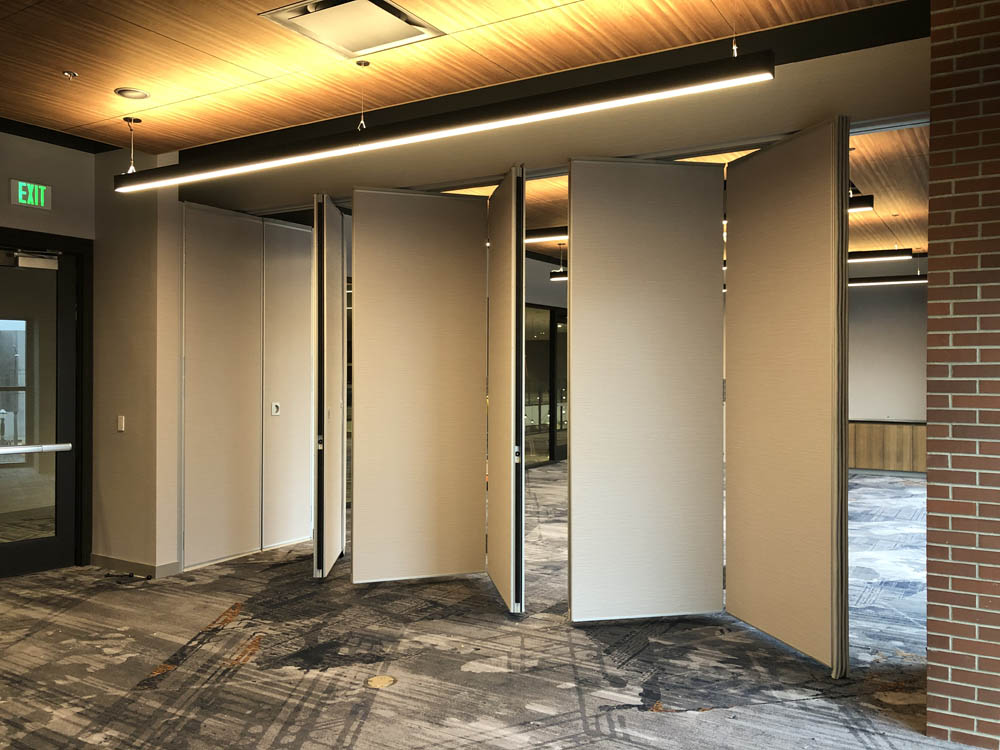
NRC (Noise Reduction Coefficient) is a single number index determined by a specific ASTM C423 test procedure used to rate the absorptive efficiency (how much of the received sound energy is absorbed) of a material from 250 Hz to 2000 Hz. Note – not from 125 Hz to 4000 Hz like the STC test procedure. The coefficients of absorption at these limited frequencies is determined and the “average” from the 4 tested frequencies is determined: this number then becomes the NRC. If an NRC is 0.00 it means that all received sound energy (0.0%) will be reflected back into the area typically from a hard surface. If the NRC rating is .90 it means that 90% of the received sound energy will be absorbed by the surface (soft flexible acoustically absorbent surface} and 10% will be reflected back into the area.
We do not believe that they work well together even though moveable walls are often specified as having to have an NRC as well as an STC.
READ THIS COMMENTARY FOR AN EXPLANATION OF OUR CONCLUSIONS.
STC is a LABORATORY sound test conducted on a representative size moveable wall specimen under perfect conditions with all sound leakage around, over & under the wall having been eliminated. Just the wall is tested.
NIC is a FIELD test conducted on a full sized moveable wall installed in the field. All sound leakage that results from gaps around, over or under the wall or leakage through the building contiguous construction becomes part of the test result. You can expect that the “Field” NIC value will be approximately 10 points less than the “Laboratory” STC: example – a Lab STC of 50 should result in an approximate Field NIC of 40. If you can achieve an NIC of 40 regardless of the STC used that is a positive result and acceptable.

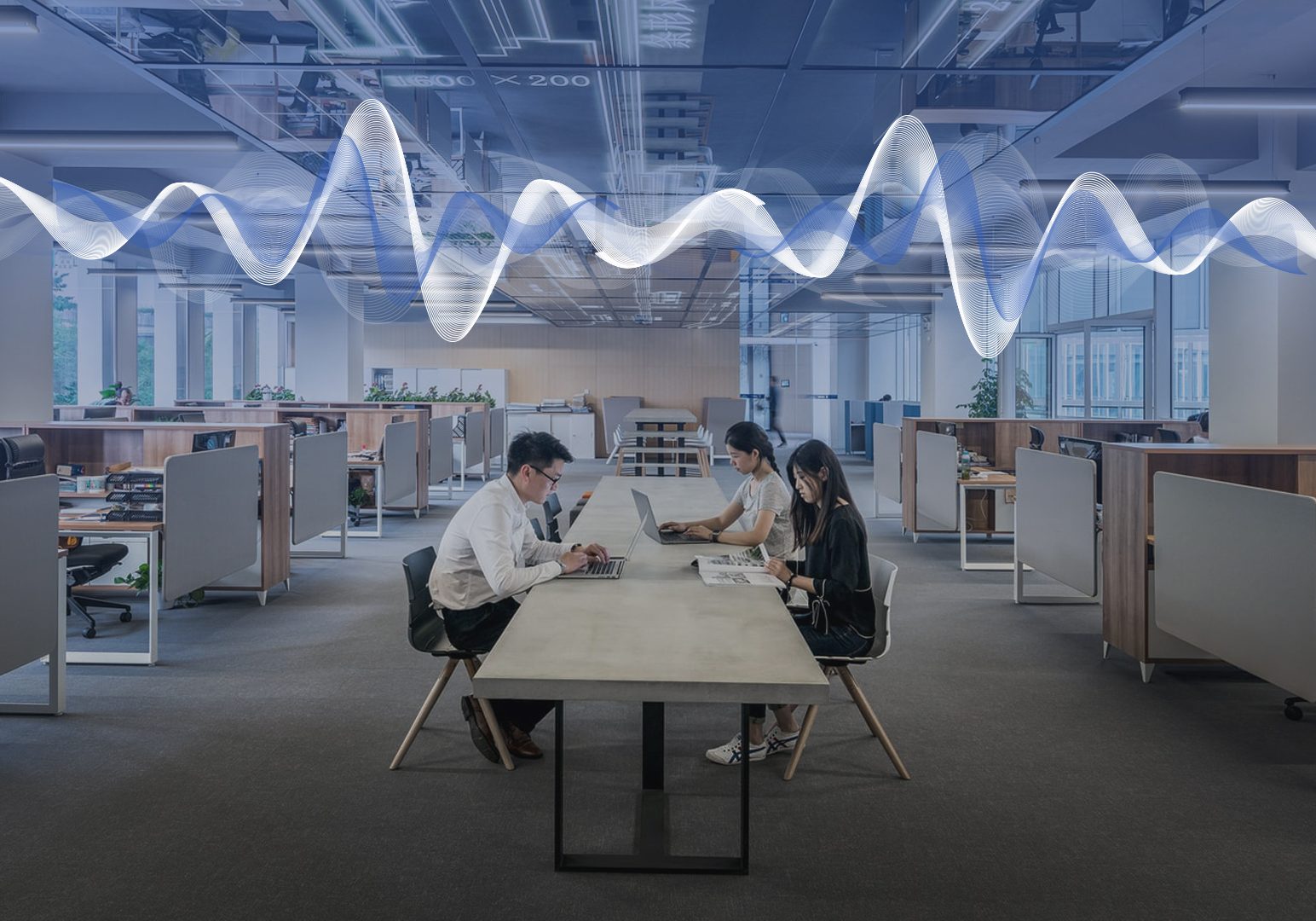
Yes. Because of the way STC is calculated (a specific test procedure with results plotted on a graph and compared to a fixed contour) a difference of 1 dB at any frequency (Hz) has the potential of changing an STC value. This 1 dB could result for example in an STC 45 instead of a 46 . But this 1 STC (or dB) difference will not have any practical impact on the acoustical effectiveness of the tested wall. The human ear cannot detect a difference of 1 dB (1 STC) within the normal speech range of sound. In practice we recommend that a baseline STC value that will meet the needs of the project be selected: as an example lets assume you select STC 55. Then the acceptable STC value (in this case 55) should be specified as “+ or -1.” So 54, 55 & 56 would be considered to be equal and acceptable and meeting the needs of the project.
ASTM E-90 is the accepted laboratory test procedure that is used to determine STC. For a detailed explanation read ASTM E-90.
In order to maximize the acoustical performance of a moveable wall you have to eliminate sound that is transmitted by means of “flanking paths” (other routes by which sound is transmitted to the other side) around , over and under the wall. Flanking paths will significantly reduce the ability of the wall to lessen transmission between the separated areas. With proper building design these issues can be eliminated. The sound reducing properties of the moveable wall is only as good as the walls contiguous construction: as a minimum the STC of surrounding construction must be equal to or preferably exceed the STC of the moveable wall. This is why it is important that the integrity of the moveable wall sound test be current and verifiable. There are 3 significant areas to consider regarding flanking paths.
Above the partition track: The track and suspension system should be enclosed from ceiling up to the underside of the structure by means of an acoustical barrier that has the same minimum STC value as the moveable wall. The entire perimeter and each joint (preferably staggered) should be caulked. All penetrations should be sealed. Any penetrations by air ducts must have silencers.
Floor surfaces: A carpeted floor is a major flanking path as sound will “leak” through the carpet fibres. Where the base acoustical seal touches the carpet, the carpet should be replaced with a continuous hard surface.
Moveable Wall to Fixed wall; If a fixed wall jamb is used then it must be caulked on both sides floor to ceiling. Provide blocking behind the permanent wall but ensure that it is discontinuous and not a solid piece through which sound vibrations can travel.
The best defense against flanking paths is to consult with Moderco as we know the “weak acoustical points” and then consider the DESIGN CRITERIA CONTAINED IN ASTM E- 557.
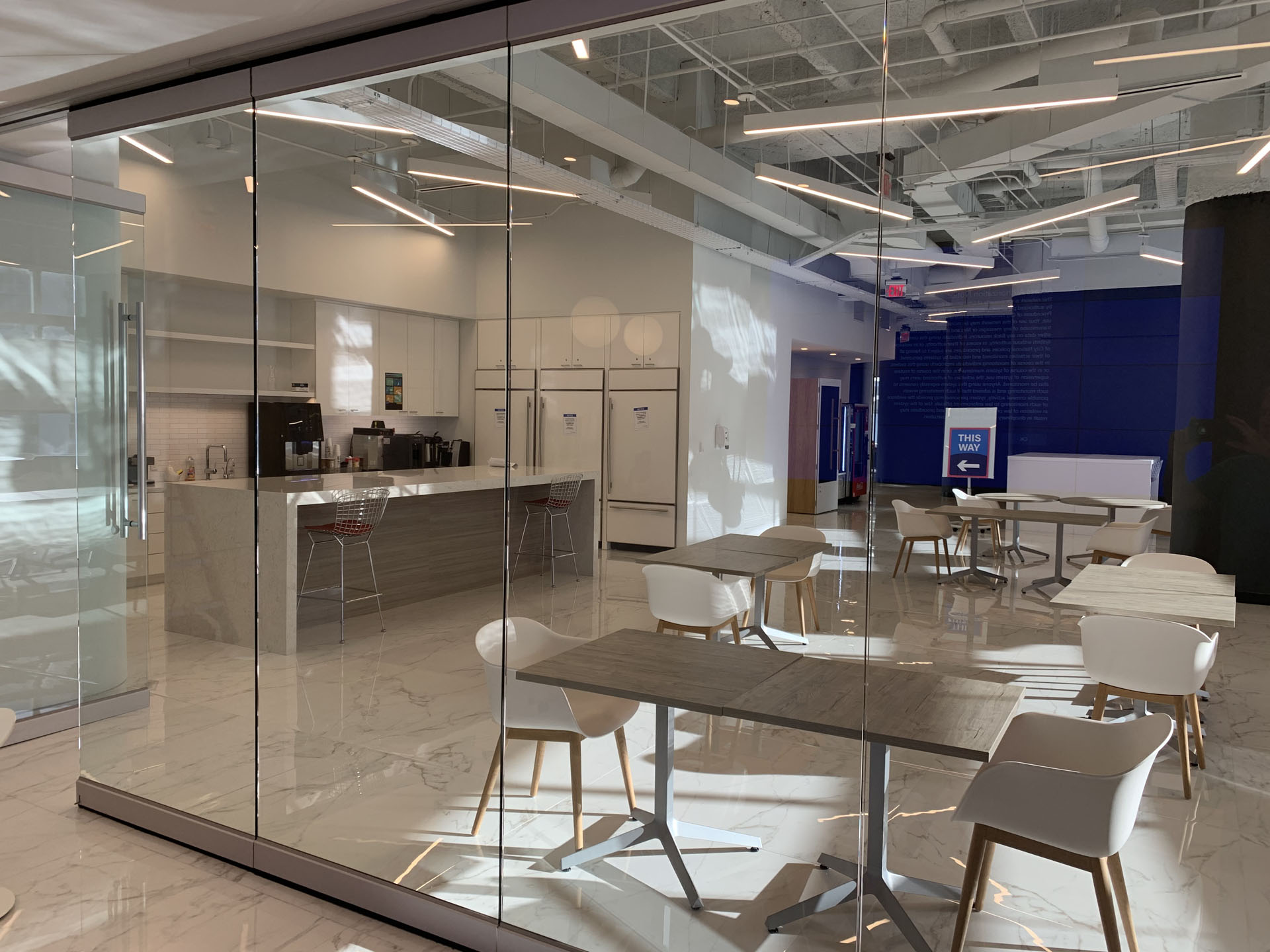
Recently a manufacturer of moveable walls and glass partitions introduced an STC 51 Glass moveable wall. What made this product unique, different and therefore attracted our attention was the fact that this “new” product achieved this unusually high STC 51 value with little apparent change to an existing product that has an STC 45. The two products appear to be virtually identical: same panel thickness, no additional absorptive materials in the panel core, same glass thickness (they do say that they use “high STC glass” which is a product that we have been unable to find or define within the glass industry.) and with an increased weight of only 1.5#/sq. ft. We have investigated as best we can using publicly available facts and compiled some information and facts regarding this achievement. If you wish to read this objectively compiled information or want to discuss please contact Moderco and we will be happy to objectively share our thoughts based on the facts as we know them.
Clients want—and need—rooms that provide speech privacy and noise control. But sometimes moveable walls alone cannot perfectly provide these features even when performing perfectly to spec. Why not? Because hearing noise or conversation from an adjacent room isn’t only based on the wall’s ability to block noise, but on two factors in the listener’s location: the level of unwanted noise/speech and the background sound level. When the first is higher than the second, noises are audible and conversations intelligible. There are steps that can be taken by the moveable wall building/ operators to improve acoustics if the wall is performing up to its ability.
Modify and adjust the source of the noise to reduce its output.
Modify, alter, better control the path by which unwanted sound is reaching the listener.
Consider what you can do in the “receivers” area to deal with the unwanted sound.
One way to deal with unwanted sound in the receivers area is to consider sound masking products.
SOUND MASKING AND MOVEABLE WALLS
For some thoughts on this topic. We also have some suggestions on the other two items noted above. Please contact us to discuss.
1. A Practical Guide to Noise Control, NBS Handbook, 119. Page 6
2. Minnesota Sustainable Housing Initiative,
3. U.S Dept. of Housing and Urban Development
4. A Practical Guide to Noise Control, NBS Handbook, 119. Page 61
5. A Practical Guide to Noise Control, Page 6.
6. Room to Room Privacy: J.T. Weissenberger
7. A Practical Guide to Noise Control”
8. United States Gypsum Wall assemblies
9. CSI
10. NRC.